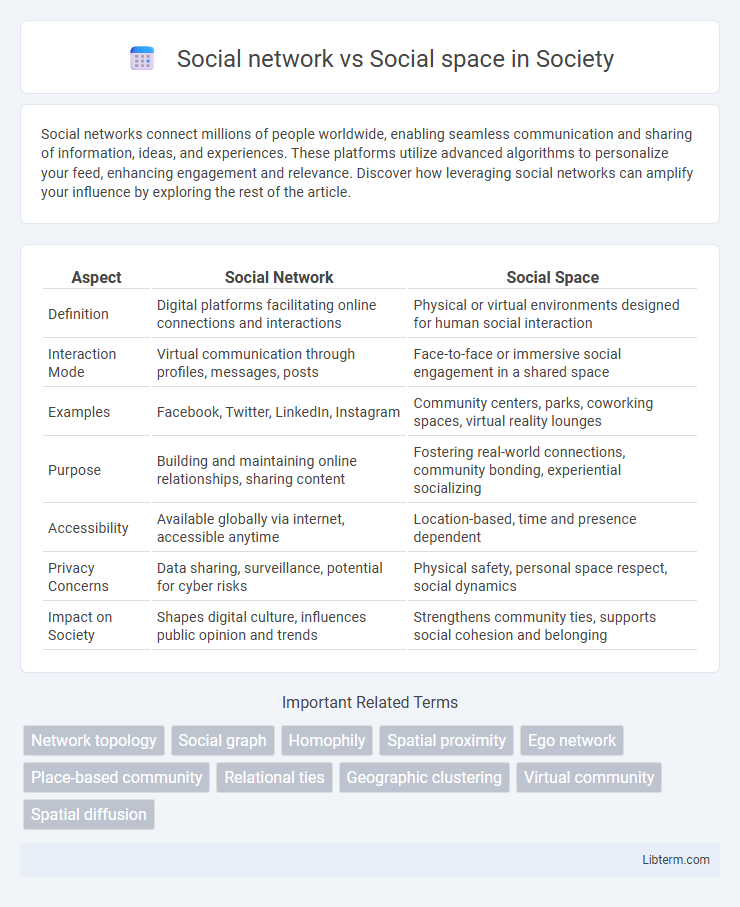Social networks connect millions of people worldwide, enabling seamless communication and sharing of information, ideas, and experiences. These platforms utilize advanced algorithms to personalize your feed, enhancing engagement and relevance. Discover how leveraging social networks can amplify your influence by exploring the rest of the article.
Table of Comparison
| Aspect | Social Network | Social Space |
|---|---|---|
| Definition | Digital platforms facilitating online connections and interactions | Physical or virtual environments designed for human social interaction |
| Interaction Mode | Virtual communication through profiles, messages, posts | Face-to-face or immersive social engagement in a shared space |
| Examples | Facebook, Twitter, LinkedIn, Instagram | Community centers, parks, coworking spaces, virtual reality lounges |
| Purpose | Building and maintaining online relationships, sharing content | Fostering real-world connections, community bonding, experiential socializing |
| Accessibility | Available globally via internet, accessible anytime | Location-based, time and presence dependent |
| Privacy Concerns | Data sharing, surveillance, potential for cyber risks | Physical safety, personal space respect, social dynamics |
| Impact on Society | Shapes digital culture, influences public opinion and trends | Strengthens community ties, supports social cohesion and belonging |
Understanding Social Networks: Core Concepts
Understanding social networks involves analyzing nodes (individuals or organizations) connected by edges representing relationships or interactions within a structured graph. Social networks emphasize patterns of communication, influence, and information flow, highlighting concepts like centrality, density, and clustering to reveal the dynamics of social ties. In contrast, social space encompasses broader socio-cultural dimensions where these networks operate, focusing on spatial and contextual factors shaping interactions.
Defining Social Spaces: Physical and Virtual Dimensions
Social spaces encompass both physical environments like parks and cafes where interpersonal interactions occur and virtual platforms such as online forums and social media networks that facilitate digital communication. These settings shape social behavior by providing context-specific opportunities for engagement, influencing the formation and maintenance of social ties. Understanding the dual dimensions of social spaces is crucial for analyzing how interactions evolve in interconnected physical and digital realms.
Historical Evolution of Social Interaction
The historical evolution of social interaction reveals a shift from traditional social spaces like public forums, marketplaces, and community centers to digital social networks enabled by the internet and mobile technology. Social networks such as Facebook and Twitter facilitate real-time communication and global connectivity, transforming how individuals form relationships and exchange information. This transition marks a significant change in social dynamics, emphasizing virtual engagement over physical presence in social spaces.
Key Features of Social Networks
Social networks are digital platforms designed to facilitate connections, communication, and content sharing among users, featuring profiles, friend or follower systems, and news feeds. Key features include real-time messaging, groups or communities based on shared interests, and algorithms that personalize content to enhance user engagement. These networks leverage user data to drive targeted advertising and foster interactive experiences, distinguishing them from broader social spaces that emphasize physical or conceptual social interactions.
Characteristics of Social Spaces
Social spaces are physical or virtual environments that facilitate meaningful human interactions, characterized by inclusivity, fluidity, and a sense of community presence. Unlike social networks, which are structured around defined connections and digital profiles, social spaces emphasize shared experiences, emotional engagement, and dynamic social norms. Key characteristics of social spaces include adaptability to participant behavior, the ability to foster collaboration, and the presence of ambient cues that enhance social bonding.
Social Networks and Community Building
Social networks serve as digital platforms where users create profiles, connect, and share content, enabling the formation of widespread communities based on interests, professions, or social identities. These platforms leverage algorithms to facilitate community building by promoting interaction, engagement, and information exchange among members, fostering collaborative environments and collective identity. Effective social networks enhance community cohesion through features like groups, events, and messaging tools that support sustained communication and shared experiences.
Social Spaces: Fostering Belonging and Identity
Social spaces create immersive environments that promote a sense of belonging and reinforce individual identity through shared experiences and meaningful interactions. Unlike social networks that prioritize connectivity and information exchange, social spaces emphasize emotional engagement and community-building, facilitating deeper social bonds. These environments leverage physical or virtual contexts to nurture trust, collaboration, and cultural expression, essential for personal and collective identity formation.
Digital Transformation: Overlap Between Networks and Spaces
Digital transformation blurs the distinction between social networks and social spaces by integrating virtual platforms where users interact, share, and collaborate beyond traditional physical boundaries. Social networks emphasize connections and information flow among individuals, while social spaces provide immersive and context-rich environments that facilitate more dynamic and multi-dimensional interactions. The convergence of these elements drives innovation in communication, engagement, and digital community building across industries.
Privacy and Security: Networks vs Spaces
Social networks prioritize user connectivity but often face challenges in privacy due to centralized data control and susceptibility to breaches. Social spaces emphasize decentralized, user-controlled environments enhancing security through encrypted interactions and minimized data collection. Choosing social spaces over traditional networks provides stronger protection against unauthorized access and data exploitation.
Future Trends in Social Connection
Social networks are evolving into immersive social spaces that integrate augmented reality and virtual environments to foster deeper, real-time interactions, transcending traditional online communication. Future trends emphasize the convergence of spatial computing and AI-driven personalization to create adaptive, context-aware social experiences that facilitate genuine human connection. This shift leverages decentralized platforms and blockchain technologies to enhance privacy, ownership, and trust within digital social ecosystems.
Social network Infographic

 libterm.com
libterm.com